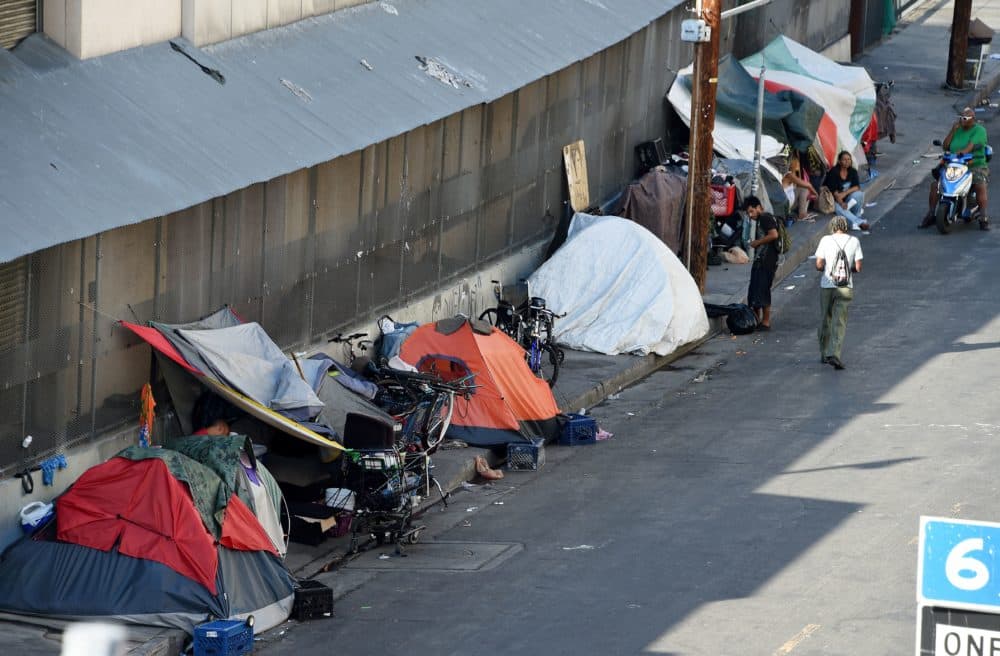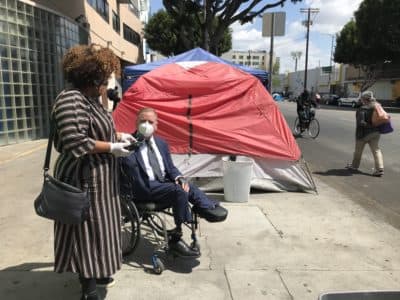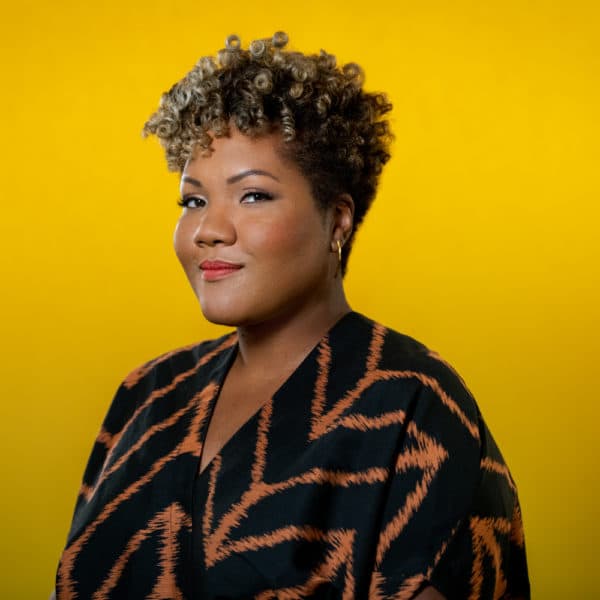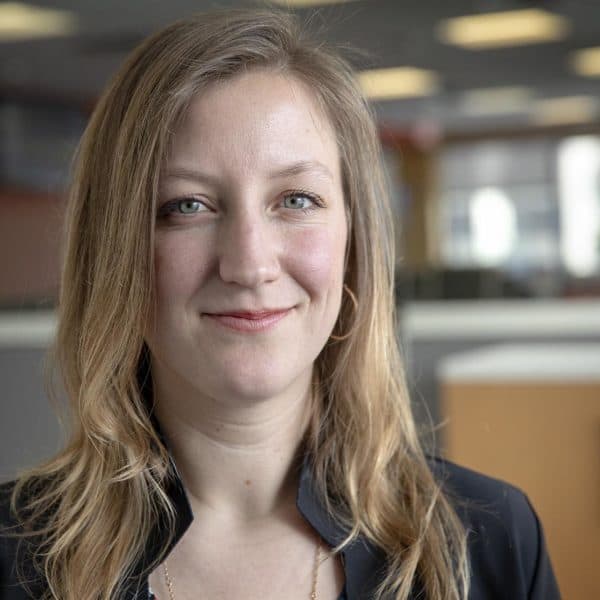Advertisement
Legal Minds Clash On How To Fix The Homeless Crisis On LA's Skid Row
Resume
In Downtown Los Angeles, 50 city blocks comprise the largest containment of unhoused people in the United States: Skid Row.
One woman who preferred not to give her name sits in a lawn chair, with all of her belongings at arm’s reach, on the sidewalk outside of the Union Rescue Mission, a nonprofit Christian organization that offers shelter and other services.
Now one of the 4,600 people living on Skid Row, she says she was once a college student. She’s been living in the neighborhood for a year and on this particular day, she wants to make certain she has a place in line for shelter when the sun goes down.
“It's hot, sometimes. It's cold, sometimes,” she says. “You have to watch yourself.”
Finding a place to sleep at night is a race against time. Unhoused people like this woman often jockey for space. Some streets in Skid Row are so congested with tents, scattered belongings and people that it’s impossible to drive or walk through.

It’s also dangerous.
Andy Bales, the CEO of the Union Rescue Mission, requested a security guard accompany himself and host Tonya Mosley during their interview. And as the interview started, they came across a person agitated by their presence.
Bales says this happens just about every day, especially during the pandemic. The lack of sidewalk space in front of the Union Rescue Mission demonstrates that Skid Row is “the worst it's ever been,” he says.
“This whole street was completely clear. But now it's rare that you can find a sidewalk that you can pass,” he says. “It's packed with people devastated by homelessness.”
Volunteer groups that used to bring aid have stopped, he says, and fentanyl has caused higher levels of overdose deaths.
Skid Row is an unofficial "containment zone" in downtown LA where the city and private organizations have provided shelters and services for homeless people for decades.
But the city’s attempt to solve the problem — by imposing anti-camping ordinances and street sweeps — have all but failed, according to federal Judge David Carter. He says LA’s decades of bad public policy decisions, mental health service failures and institutional racism have contributed to a disaster that can only be solved by forcing the city’s hand.
The judge ruled last month that LA must provide or offer shelter to Skid Row's unhoused by Oct. 18. Women and children must be offered housing within 90 days.
The ruling is in response to a lawsuit filed last year by a group of downtown business owners and community members. Bale supports the order.
“One of the biggest heartbreaks for me is seeing beautiful people of color suffer inordinately on the streets of Skid Row,” he says. “That's why I'm so for the judge's injunction, because it's all based on reversing the wrongs that have been done to people, especially people of color.”
The injunction calls for the city to also put $1 billion into an escrow account to help fund this effort. But other than that, the way the city and county should go about it isn’t clear. Some housing advocates fear the lack of instructions may lead to an increase in shelters, versus long-term solutions like permanent housing.
Eric Tars, legal director for the National Homelessness Law Center, says the judge’s ruling is like a doctor getting the diagnosis right but the prescription wrong.
Judges often strike down ordinances that criminalize people experiencing homelessness who perform basic activities in public, such as sleeping and taking shelter, he says. But these ordinances often reemerge in other forms.
The judge’s order will make the problem worse because “he's focusing on shelter solutions rather than on housing,” Tars says.
“The only way to actually remedy the continuing constitutional violation in these sorts of cases is by getting to the root of the problem, which is that homelessness exists,” he says, “and the only way to do that is to actually get people into adequate housing.”
The order allows the city to enforce anti-camping ordinances, he says. Tars fears the order could create the situation housing advocates thought former President Donald Trump would spark last year with an executive order: Unhouse people being held in camps under threat of arrest.
Los Angeles County has filed an appeal against the judge's ruling. The 9th Circuit Court of Appeals could strike down the order on procedural grounds, Tars says, or the city and county can reach a settlement with the plaintiffs in the case, to provide a better outcome.
Shelters play an important role in homeless systems during emergency situations, but Tars says the focus should be on housing policies in LA that promote the growth of high-end housing over affordable housing.
And Biden’s American Jobs Plan and American Families Plan could give Los Angeles resources to make progress on this issue more quickly, he says.
“The urgency is there. But in this case, a big part of the solution may be right around the corner,” he says. “And so rushing into something now, it's not the time for that.”
Bales with the Union Rescue Mission says he doesn’t disagree with Tars. Sustainable long-term housing is the ultimate solution — but in the short term, he believes getting people out of dangerous and unsanitary conditions should be the first priority.
And if temporary shelters are the way to do that, Bales is ready to see it. Anything to offer some relief, he says.
“If you're on the streets, you never get a chance to rest. I mean, how much do you and I cherish sleep at night? How much do I cherish a nap when I'm exhausted?” he says. “People who are devastated by homelessness can never get that rest that's needed for you to be human.”
Ashley Locke produced and edited this interview for broadcast with Eileen Bolinsky. Allison Hagan adapted it for the web.
This segment aired on May 10, 2021.


